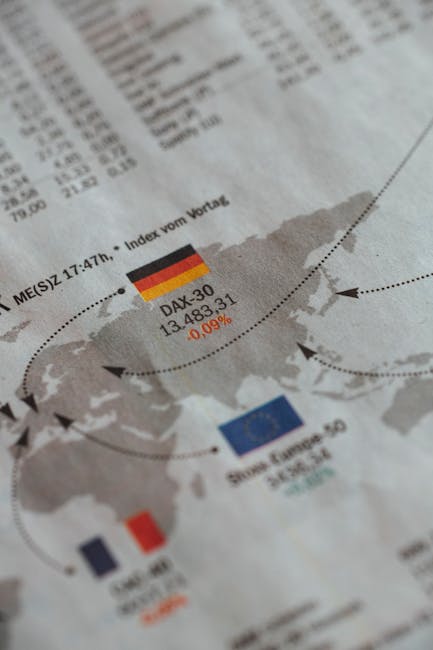Explore the comprehensive differences between the DAX 30 and DAX 40, Germany’s leading stock market indices. This article delves deep into the DAX index composition, historical evolution, and its impact on investors looking to understand the German stock market index, trading DAX, and investing in DAX effectively.
DAX 30 vs DAX 40: Understanding the Evolution of Germany’s Benchmark Index
The recent transition from the DAX 30 to the DAX 40 has sparked considerable interest among investors, traders, and financial analysts worldwide. If you’re searching for a clear and detailed explanation of “DAX 30 vs DAX 40,” you’ve come to the right place. This guide explores the reasons behind the evolution, the differences in index composition, and the broader implications for the German stock market index and its blue-chip companies. Whether you’re analyzing DAX historical data or tracking DAX performance today, this article will equip you with essential knowledge to navigate the Frankfurt Stock Exchange with confidence.
1. The DAX Index: A Brief Overview

What Is the DAX Index?
The DAX, or Deutscher Aktienindex, is the foremost stock market index in Germany, representing the 40 largest and most liquid companies traded on the Frankfurt Stock Exchange. Known by its ticker symbol GDAXI, the DAX serves as a vital barometer of the German economy and European market trends.
The Significance of the DAX in Global Markets
As an aggregation of blue-chip companies in Germany, the DAX reflects international economic conditions and investor sentiment. Many market participants use the index to gauge economic health and perform comparative analyses against other global indices such as the Dow Jones or FTSE 100.
2. DAX 30 Explained: Origins and Composition

History and Development of the DAX 30
Launched in 1988, the DAX 30 was Germany’s primary benchmark, consisting of the 30 largest companies by market capitalization and trading volume. For over three decades, it was the definitive measure of German blue-chip stocks. The index’s straightforward focus allowed investors to track the performance of the country’s most influential corporations, from automotive giants to chemical industry leaders.
DAX Index Composition Under the DAX 30
The DAX 30 included well-known companies like Siemens, Volkswagen, BASF, and Deutsche Bank—names emblematic of Germany’s industrial and technological strength. The selection criteria emphasized:
- Market capitalization: The largest companies by free-float market cap.
- Trading volume: High liquidity to ensure smooth trading and accurate market representation.
- Sector representation: Diversification across key industries like manufacturing, finance, and technology.
While the DAX 30 was comprehensive, certain sectors and mid-cap companies remained underrepresented, a challenge the index’s redesign sought to address.
3. Transition to DAX 40 Explained: Why the Expansion?

The Rationale Behind Increasing to 40 Components
In September 2021, Deutsche Börse expanded the DAX from 30 to 40 companies. This change was motivated by multiple factors:
- Enhanced Market Representation: Including 10 additional companies allows for a broader snapshot of the German economy, covering emerging sectors and promising medium-sized firms.
- Improved Index Stability: More constituents reduce concentration risk, meaning the performance of a few companies less disproportionately affects the index.
- Alignment with International Standards: Many global indices track 40 or more companies; Germany’s upgrade fostered greater competitiveness in index products and ETFs.
- Addressing Past Limitations: Certain blue-chip companies and high-performing firms were excluded due to the 30-company limit, which the new DAX structure resolves.
Changes in Inclusion Criteria and Rules
Besides increasing the number of companies, inclusion criteria became stricter to ensure higher quality and transparency:
- Free-float market capitalization: Companies must meet higher thresholds.
- Transparency and reporting standards: New requirements for corporate disclosures promote investor trust.
- Liquidity measures: Enhanced evaluation of trading volumes to maintain liquidity.
4. Differences in DAX Index Composition: DAX 30 vs DAX 40
Comparing Constituent Companies
The DAX 40 now includes well-established heavyweights plus fresh entrants from growth-oriented industries such as technology, e-commerce, and renewable energy. As a result, the German stock market index has become more balanced and reflective of current economic realities.
Sectoral Shifts and Broader Representation
While the traditional DAX 30 was dominated by automotive, manufacturing, and finance sectors, the DAX 40 introduces diversity by adding companies from:
- Information Technology
- Healthcare and Biotechnology
- Consumer Services
- Renewable Energies
This evolution has improved the index’s resilience to sector-specific shocks and enhanced its appeal for global investors.
Impact on Weightings and Volatility
The addition of ten companies spreads the weighting more evenly. Large cap giants still dominate but no longer overshadow the index completely, leading to reduced volatility and a more representative performance metric.
5. What the Shift Means for Investors and Traders
Implications for Investing in DAX
Investors benefit from the DAX 40 expansion in multiple ways:
- Greater Diversification: Reduced concentration risk lowers portfolio volatility when investing in DAX ETFs and index funds.
- Access to Growth Companies: Investors gain exposure to innovative sectors previously underrepresented.
- Improved Transparency: Updated rules mean companies included are more accountable, enhancing investment quality.
Trading DAX: What Has Changed?
For traders, understanding the DAX 30 vs DAX 40 dynamics is crucial. Increased constituents have slightly altered price action, liquidity patterns, and volatility characteristics. Market participants must adjust strategies to factor in the broader array of companies influencing the GDAXI index.
Evaluating DAX Performance Today
Tracking DAX performance today requires attention to both old blue-chip stalwarts and new entrants. While the overall market trend still mirrors the German economy’s health, the DAX 40’s composition renders it a more reliable indicator for medium- and long-term forecasts, aligning well with global economic shifts.
6. Analyzing DAX Historical Data in Light of the Change
Comparing historical DAX 30 data with DAX 40 requires careful consideration due to changes in composition and weighting methodologies. Analysts must adjust their models to incorporate the additional companies, ensuring valid trend analysis and market forecasting.
However, the expanded dataset allows for more sophisticated analysis, including:
- Sector rotation insights
- Correlation studies between traditional industrial sectors and emerging industries
- Volatility and risk management improvements
Frequently Asked Questions (FAQ)
What is the main difference between DAX 30 and DAX 40?
The fundamental difference is the number of companies included. The DAX 30 covered the 30 largest German companies by market value and liquidity, while the DAX 40 expanded this to 40 companies, enhancing sector coverage and reducing index concentration.
Why did the Frankfurt Stock Exchange increase the index size?
The expansion aimed to better represent the German economy, improve stability by lowering concentration risk, and align the DAX with international benchmark standards for greater attractiveness to investors.
How does the DAX 40 affect investors compared to the DAX 30?
Investors now have access to a broader range of companies, including fast-growing sectors, improving diversification and reducing risks associated with overreliance on a handful of large firms.
Can I still use DAX historical data from the DAX 30 for analysis?
Yes, but with caution. Historical DAX 30 data provides valuable context but must be adjusted to consider differences in composition and weighting for accurate comparison with DAX 40 performance.
Summary and Call to Action
Understanding the DAX 30 vs DAX 40 evolution is essential for anyone engaging with the German stock market index. The transition to a 40-company structure reflects both market maturity and adaptation to global financial standards. It offers enhanced representation, improved risk management, and greater investment opportunities across diverse sectors.
Whether you are trading DAX daily or investing in DAX for the long term, staying informed about these changes empowers you to make smarter decisions aligned with current economic dynamics.
For an expert assessment of trading instruments and detailed reviews of platforms that support investing in DAX, explore our professional guide at Brokereviews.com Pro Dark. Equip yourself with the latest insights tailored for the evolving financial landscape.








